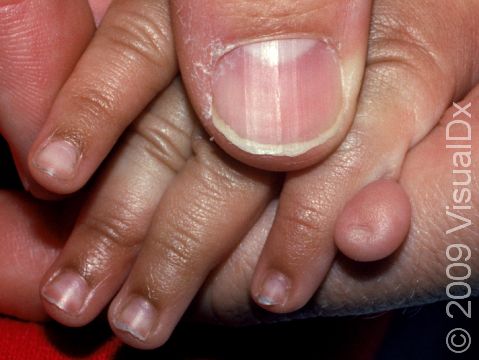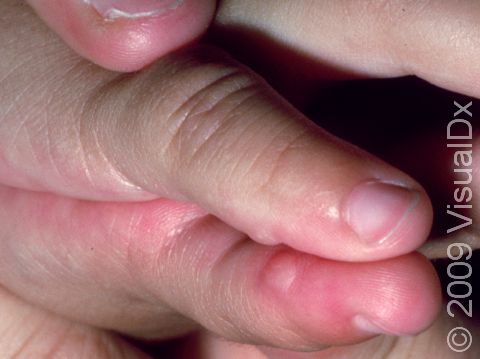Polydactyly (Supernumerary Digit)
Supernumerary digits refer to the occurrence of extra (more than 10) fingers, toes, or parts of these digits. The medical term for this condition is polydactyly. The diagnosis can be divided into 3 classifications: extra digits that occur on the side of the thumb or big toe, extra digits that occur on the side of the little finger or the last toe (most common), and those that involve the fingers or toes in the middle.
Who's At Risk?
Extra digits occur in about 0.05% of the population (very rare). It is on both hands or feet in about 50% of those cases. It may occur in infants who have a family history, as it can be inherited. It is more common in African American infants.
Signs & Symptoms
A supernumerary digit most commonly occurs on the little finger. The extra digit may be only flesh and skin, or there may be bone underneath. It may appear to be floating (called a nubbin) and connected by a stalk, with a normal-appearing nail at the end. It may be an isolated finding at birth, or it may be seen with other symptoms or features. When it occurs with other features, it may be related to a genetic condition involving an extra part of or whole chromosome. The extra digit may or may not be seen on prenatal ultrasound.
Self-Care Guidelines
There are no self-care guidelines if your infant has this diagnosis; it requires surgical intervention. Extra digits should not be “tied off” at home.
Treatments
The treatment is surgical removal of the extra digit by a subspecialist. The goals of surgery are to cosmetically improve the appearance of the hand or foot and also to prevent progressive deformity as your infant grows. The surgery for fully formed extra digits (bone, flesh, and skin) is often deferred until about 9–12 months of age so your infant can better tolerate the anesthesia involved in the surgery. However, small, bone-less digits may be surgically removed earlier. The prognosis for this minor surgery is excellent.
Visit Urgency
This diagnosis is made at birth and may require an X-ray to determine whether there is underlying bone in the extra digit. Once the diagnosis is made, there is essentially nothing to do until it can be surgically removed. If any color change or decrease in hand/foot functioning is noted, it is important to contact your baby’s pediatrician. Some parents may note that once their infant starts to wear shoes it becomes uncomfortable.
References
Behrman RE, Kliegman R, Jensen HB, eds. Nelson Textbook of Pediatrics. 18th ed. Philadelphia, PA: WB Saunders; 2007.
Gore AK, Spencer JP. The newborn foot. Am Fam Physician. 2004;69(4):865-872.
Shafi M, Hui JH. Common paediatric orthopaedic problems in the upper limb. Singapore Med J. 2006;47(8):658.
Zitelli BJ. Atlas of Pediatric Physical Diagnosis. Davis H, ed. New York, NY: Mosby Inc; 2007.
Last modified on October 5th, 2022 at 8:02 pm

Not sure what to look for?
Try our new Rash and Skin Condition Finder

